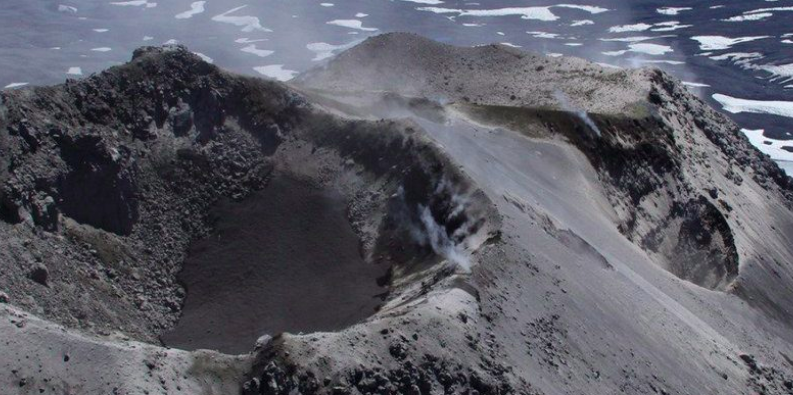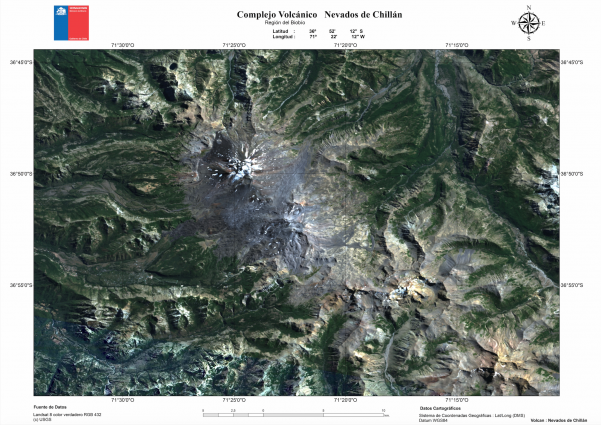

Image via GlacierHub.
Help EarthSky keep going! Please donate what you can to our once-yearly crowd-funding campaign.
This article is republished with permission from GlacierHub. This post was written by Arley Titzler.
Stretching over 4,350 miles (7,000 km) across seven countries, the Andes are the world’s longest mountain range. They make up the southeastern portion of the Ring of Fire and are well-known for their abundant volcanoes.
The Chilean Andes are home to 90 active volcanoes, all monitored by the Chilean National Geology and Mining Service (Sernageomin). The agency categorizes volcanic activity using four distinct alert levels: green (normal level of activity), yellow (increased level of activity), orange (probable development of an eruption in the short-term), and red (eruption is ongoing or imminent). Increased volcanic activity is associated with frequent earthquakes; plumes of gas, rocks, or ash; and lava flows.
Two areas monitored by Sernageomin are currently showing signs of increased activity: the Nevados de Chillán and Planchón-Peteroa volcanic complexes. The agency issued orange and yellow alert levels for them, respectively.

A satellite image of the Nevados de Chillán volcano complex, showing the glacier-covered volcano peaks. Image via Sernageomin.
Nevados de Chillán Volcanoes: Orange Alert
The Nevados de Chillán volcano complex is comprised of several glacier-covered volcanic peaks. When these volcanoes erupt, the glacial ice sitting atop them melts and mixes with lava, which can result in dangerous lahars, or mudflows. Several small earthquakes and the formation of new gas vents led Sernageomin to issue a yellow alert on December 31, 2015. (To view a detailed map of the Nevados de Chillán complex, click here.)
#VolcánNevadosDeChillán No acercarse a menos de 2k de cráteres activos: https://t.co/a6fBWzj23l 30-1-2016 pic.twitter.com/Gl7ELOkM5O
— Sernageomin (@Sernageomin) January 31, 2016
Volcán Nevados del Chillán registra nuevo pulso eruptivo, actividad normal dentro la alerta amarilla, Región del Bio-Bio, Chile @GOB_NUBLE pic.twitter.com/Vok3cq5CFZ
— EarthQuakesTime (@EarthQuakesTime) August 11, 2017
On April 5, 2018, Sernageomin upgraded the Nevados de Chillán’s yellow alert to an orange alert, following thousands of tremors and a thick, white column of smoke rising from the area. This signaled the likelihood of an eruption in the near future.
Throwback: 1.4 km high ash column from Nevados de Chillan volcano's eruption on 14 July 2018, Chile's large composite stratovolcanic complex composed of 3 overlapping #stratovolcanoes(Volcan Nevado, Volcan Chillan & Volcan Nuevo) on a NNW-SSE- trending line – P.S. Miranda's photo pic.twitter.com/teNFiFIQL4
— jaime s. sincioco (@jaimessincioco) August 11, 2018
Sernageomin’s most recent volcanic activity report for Nevados de Chillán, issued on February 11, 2019, cited persistent seismic activity, which is directly related to increased frequency of explosions, along with the growth and/or destruction of the lava dome that lies in the crater. The expected eruption is most likely to have moderate to low explosive power, but sporadic observations over the last year have shown higher than average energy levels.
El #volcanNevadosdeChillan encendió su turbina.En el 5'' y en el 20'' el viento permite escuchar su rugido. Video Carlos Quijada subiendo el Nevado.@cfariasvega @Lapidus91 @volcanologiachl @volcanesdechile @Sernageomin @Geolascar @RadioNuble@ladiscusioncl @canal13 @CHVNoticias pic.twitter.com/X4hkEuBlII
— J o r g E (@Sir_Balthus) September 4, 2018
On February 15, 2019, the Volcanic Ash Advisory Center in Buenos Aires documented a volcanic-ash plume reaching 12,139 feet (3,700 meters) high at Nevados de Chillán, an example of the above mentioned “higher than average energy levels.”
Nevados de Chillan, Chile's composite stratovolcanic complex of 3 overlapping stratovolcanoes (Nevado, Chillan & Nuevo) was monitored #erupting on 31 Jan 2019. Seismograph recorded LP quake, tremor & volcano-tectonic quake during the past observation period- Source: Sernageomin pic.twitter.com/ApWcJv5UFR
— jaime s. sincioco (@jaimessincioco) February 2, 2019
The Nevado de Chillan volcano in central Chile shows signs of increasing activity as white smoke emerges from its crater pic.twitter.com/OBVKmWsxOk
— AFP news agency (@AFP) April 8, 2018
Bottom line: Recent increased volcanic activity in the Nevados de Chillán prompted Chilean authorities to issue an orange alert in anticipation of an eruption.
from EarthSky https://ift.tt/2Nz7Ij5


Image via GlacierHub.
Help EarthSky keep going! Please donate what you can to our once-yearly crowd-funding campaign.
This article is republished with permission from GlacierHub. This post was written by Arley Titzler.
Stretching over 4,350 miles (7,000 km) across seven countries, the Andes are the world’s longest mountain range. They make up the southeastern portion of the Ring of Fire and are well-known for their abundant volcanoes.
The Chilean Andes are home to 90 active volcanoes, all monitored by the Chilean National Geology and Mining Service (Sernageomin). The agency categorizes volcanic activity using four distinct alert levels: green (normal level of activity), yellow (increased level of activity), orange (probable development of an eruption in the short-term), and red (eruption is ongoing or imminent). Increased volcanic activity is associated with frequent earthquakes; plumes of gas, rocks, or ash; and lava flows.
Two areas monitored by Sernageomin are currently showing signs of increased activity: the Nevados de Chillán and Planchón-Peteroa volcanic complexes. The agency issued orange and yellow alert levels for them, respectively.

A satellite image of the Nevados de Chillán volcano complex, showing the glacier-covered volcano peaks. Image via Sernageomin.
Nevados de Chillán Volcanoes: Orange Alert
The Nevados de Chillán volcano complex is comprised of several glacier-covered volcanic peaks. When these volcanoes erupt, the glacial ice sitting atop them melts and mixes with lava, which can result in dangerous lahars, or mudflows. Several small earthquakes and the formation of new gas vents led Sernageomin to issue a yellow alert on December 31, 2015. (To view a detailed map of the Nevados de Chillán complex, click here.)
#VolcánNevadosDeChillán No acercarse a menos de 2k de cráteres activos: https://t.co/a6fBWzj23l 30-1-2016 pic.twitter.com/Gl7ELOkM5O
— Sernageomin (@Sernageomin) January 31, 2016
Volcán Nevados del Chillán registra nuevo pulso eruptivo, actividad normal dentro la alerta amarilla, Región del Bio-Bio, Chile @GOB_NUBLE pic.twitter.com/Vok3cq5CFZ
— EarthQuakesTime (@EarthQuakesTime) August 11, 2017
On April 5, 2018, Sernageomin upgraded the Nevados de Chillán’s yellow alert to an orange alert, following thousands of tremors and a thick, white column of smoke rising from the area. This signaled the likelihood of an eruption in the near future.
Throwback: 1.4 km high ash column from Nevados de Chillan volcano's eruption on 14 July 2018, Chile's large composite stratovolcanic complex composed of 3 overlapping #stratovolcanoes(Volcan Nevado, Volcan Chillan & Volcan Nuevo) on a NNW-SSE- trending line – P.S. Miranda's photo pic.twitter.com/teNFiFIQL4
— jaime s. sincioco (@jaimessincioco) August 11, 2018
Sernageomin’s most recent volcanic activity report for Nevados de Chillán, issued on February 11, 2019, cited persistent seismic activity, which is directly related to increased frequency of explosions, along with the growth and/or destruction of the lava dome that lies in the crater. The expected eruption is most likely to have moderate to low explosive power, but sporadic observations over the last year have shown higher than average energy levels.
El #volcanNevadosdeChillan encendió su turbina.En el 5'' y en el 20'' el viento permite escuchar su rugido. Video Carlos Quijada subiendo el Nevado.@cfariasvega @Lapidus91 @volcanologiachl @volcanesdechile @Sernageomin @Geolascar @RadioNuble@ladiscusioncl @canal13 @CHVNoticias pic.twitter.com/X4hkEuBlII
— J o r g E (@Sir_Balthus) September 4, 2018
On February 15, 2019, the Volcanic Ash Advisory Center in Buenos Aires documented a volcanic-ash plume reaching 12,139 feet (3,700 meters) high at Nevados de Chillán, an example of the above mentioned “higher than average energy levels.”
Nevados de Chillan, Chile's composite stratovolcanic complex of 3 overlapping stratovolcanoes (Nevado, Chillan & Nuevo) was monitored #erupting on 31 Jan 2019. Seismograph recorded LP quake, tremor & volcano-tectonic quake during the past observation period- Source: Sernageomin pic.twitter.com/ApWcJv5UFR
— jaime s. sincioco (@jaimessincioco) February 2, 2019
The Nevado de Chillan volcano in central Chile shows signs of increasing activity as white smoke emerges from its crater pic.twitter.com/OBVKmWsxOk
— AFP news agency (@AFP) April 8, 2018
Bottom line: Recent increased volcanic activity in the Nevados de Chillán prompted Chilean authorities to issue an orange alert in anticipation of an eruption.
from EarthSky https://ift.tt/2Nz7Ij5

Aucun commentaire:
Enregistrer un commentaire